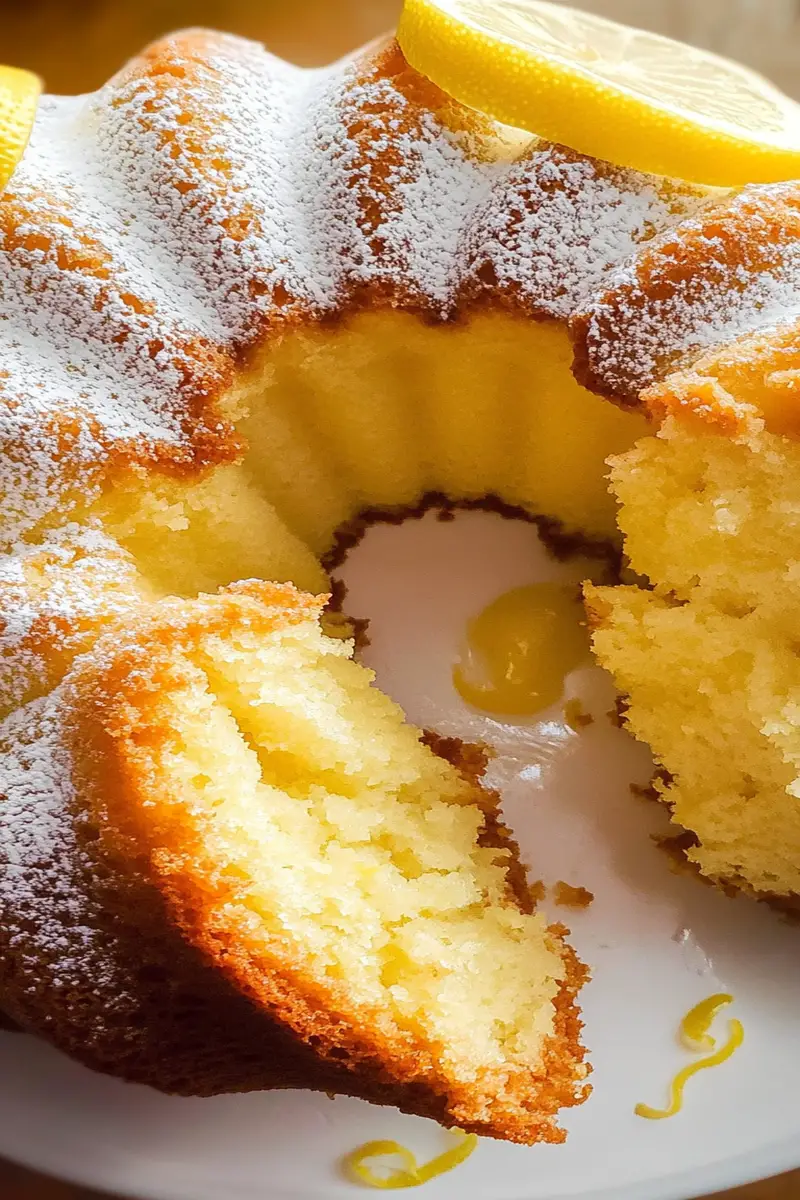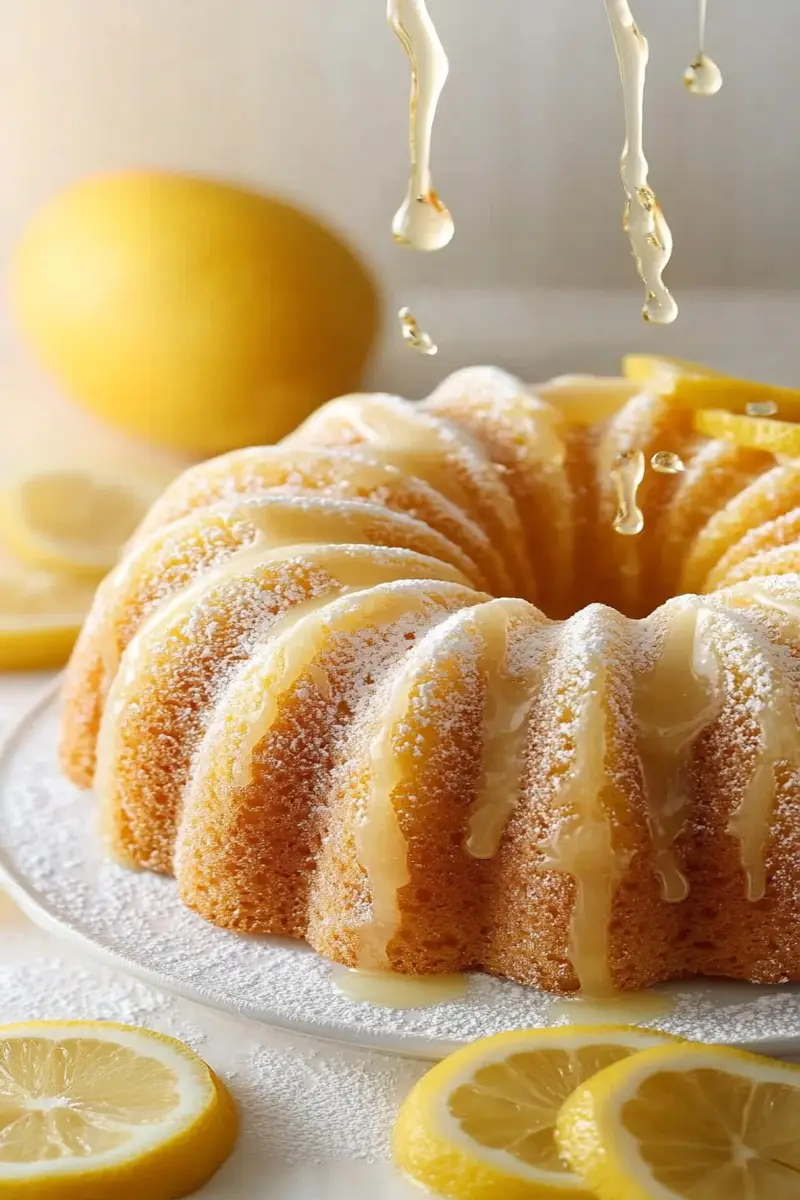Introduction and Quick Summary
Lemon Bundt Cake is a delightful treat that combines the bright flavor of fresh lemons with a moist and tender crumb. Whether you are celebrating a special occasion or simply looking for a comforting dessert, this cake is sure to impress. The zesty taste of lemons invigorates the palate while the soft texture melts in your mouth. This recipe is straightforward and requires minimal prep time, making it accessible for bakers of all skill levels.
Imagine serving this stunning cake at your next gathering; its beautiful shape and vibrant flavor will have everyone asking for seconds. Each slice reveals a luscious interior that is not only satisfying but also visually appealing. The addition of a light glaze enhances the sweetness without overpowering the citrus notes. With just a handful of ingredients and step-by-step instructions, you can create this scrumptious Lemon Bundt Cake in no time.
In this article, you’ll find detailed information on the main ingredients needed to craft this masterpiece. Following that, we will provide clear instructions on how to prepare your Lemon Bundt Cake from scratch. Finally, we’ll share some great serving suggestions along with tips on how to store any leftovers. Prepare to indulge in this delightful dessert that’s perfect for any occasion.
Main Ingredients
All-Purpose Flour
The foundation of any great cake is the flour. For our Lemon Bundt Cake, you’ll need 2 cups of all-purpose flour. This ingredient provides structure and stability while keeping the cake light and fluffy. When measuring flour, make sure to aerate it first by fluffing it up with a spoon before spooning it into your measuring cup. This prevents packing too much flour into your measurement.
Granulated Sugar
You will require 1 ½ cups of granulated sugar for sweetness in the cake and an additional ½ cup for the glaze later on. The sugar not only sweetens but also helps maintain moisture within the cake’s crumb structure. It is essential to mix sugar well with butter during creaming as it incorporates air into the batter for a lighter texture.
Unsalted Butter
Using ½ cup (1 stick) of unsalted butter adds richness to your Lemon Bundt Cake. Ensure that the butter is at room temperature so it can blend smoothly with sugar for an even batter consistency. If you prefer a slightly more pronounced lemon flavor, consider using salted butter as it can enhance other flavors.
Eggs
You will need 3 large eggs at room temperature to act as binders in the recipe. Eggs provide moisture and help give structure to baked goods. Adding them one at a time during mixing allows each egg to incorporate fully into the batter before adding another.
Fresh Lemons
For optimal flavor, use 3 large fresh lemons—both juice and zest are required in this recipe. The zest contains essential oils that deliver intense lemony aroma and taste while juice brings moisture and acidity necessary for balance in flavor profiles.
Baking Powder
You will need 2 teaspoons of baking powder as your leavening agent to ensure proper rise in your bundt cake while keeping it light and airy. It reacts with acidic ingredients like lemon juice to create carbon dioxide bubbles that help lift the batter during baking.
Milk
Adding ½ cup of milk enhances moisture content in your batter without making it too dense or heavy. You can use whole milk or any dairy-free alternative based on dietary preferences; just ensure it’s at room temperature before mixing.
Vanilla Extract
For added depth of flavor, include 1 teaspoon of vanilla extract which complements the bright notes from lemons beautifully without overpowering their freshness.

How to Prepare Lemon Bundt Cake
Step One: Preheat Your Oven
Start by preheating your oven to 350°F (175°C). Preheating ensures that your cake bakes evenly from start to finish; if you place batter into an unheated oven, it may not rise properly or could cook unevenly leading to undesired textures.
Make sure you have your bundt pan ready—grease it generously with butter or cooking spray along with dusting flour inside so that the cake releases easily after baking without sticking.
Step Two: Cream Butter and Sugar
In a large mixing bowl, combine softened unsalted butter (½ cup) with granulated sugar (1 ½ cups). Use an electric mixer on medium speed until pale yellow and fluffy; this process typically takes about 3-5 minutes depending on mixer power.
Creaming incorporates air into mixture resulting in lighter texture post-baking; make sure all butter has blended uniformly into sugar before proceeding further.
Step Three: Add Eggs One at a Time
Next up are eggs—crack open three large eggs one by one into mixture ensuring no shells slip inside! Mix each egg thoroughly after adding before moving onto next addition; aim for about one minute per egg until fully incorporated before continuing onward with recipe steps ahead!
This gradual incorporation helps maintain stable emulsion within batter which translates directly into silky smooth final product once baked correctly!
Step Four: Incorporate Dry Ingredients
In separate bowl sift together all-purpose flour (2 cups), baking powder (2 teaspoons), along with salt if desired (typically around ¼ teaspoon). After mixing dry ingredients well together slowly add them alternatively along with milk (½ cup) starting & ending with flour mixture while continuously blending until just combined—this ensures no overmixing occurs leading towards denser outcomes overall!
Add freshly squeezed lemon juice & zest from three lemons right into combined blend stirring gently until everything has come together perfectly without lumps remaining visible throughout mixture itself!
Step Five: Pour Batter Into Pan
Now pour prepared batter carefully into greased bundt pan using rubber spatula scraping down sides ensuring even distribution across bottom surface area evenly throughout entire pan itself!
Take care not fill past halfway point since cakes tend expand during baking process as leavening agents activate creating volume within final product themselves! Bake at preheated temperature range set earlier until toothpick inserted comes out clean around upper edges typically lasting anywhere between thirty-five-forty-five minutes depending upon individual oven calibrations overall performance metrics applied here!

Serving and Storing Tips
Serving Suggestions
Once cooled completely on wire rack after removing from oven allow approximately ten minutes resting period prior flipping upside down onto serving platter carefully releasing edges gently using spatula if necessary ensuring no parts stick behind making appearance visually appealing when served!
Slice evenly through each portion providing guests generous servings without compromising aesthetics presented overall theme surrounding event taking place here today! Consider dusting powdered sugar over top surface layer lightly enhancing visual appeal alongside adding sweetness without overwhelming primary flavors showcased throughout entire dish itself!
Pair slices alongside dollop whipped cream or scoop vanilla ice cream enhancing experience elevating flavors further whilst counteracting tartness found naturally occurring from lemons present throughout entire dish itself creating harmonious balance enjoyed thoroughly!
Storing Leftovers
If there happens remain any leftovers following delightful gathering don’t fret about wasting such exquisite creation! Store tightly wrapped within plastic wrap allowing minimal exposure air preventing drying out excessively over time keeping freshness intact longer durations utilizing airtight containers could prove beneficial as well depending upon available options present locally too!
Best kept refrigerated extending shelf life approximately five days maximum maintaining quality retained previously experienced initially upon first taste presentation! If ever wanting prolong enjoyment even longer freezing options available too; simply slice beforehand packaging accordingly preventing freezer burn occurring effectively sealing edges tightly prior sending off into storage awaiting future indulgences down road when cravings arise unexpectedly again soon afterward arriving back home once again feeling contentment achieved previously experienced moments shared around dining table earlier together amidst friends family alike gathered celebrating joyful memories created anew displayed proudly made right kitchen space nearby always ready whenever needed next opportunity arises again soon enough coming along shortly thereafter!
This Lemon Bundt Cake offers both ease preparation alongside delectable flavor profiles guaranteed delight anyone willing try piece slice sharing joyfully amongst loved ones cherished forevermore!
Mistakes to avoid
One common mistake when baking a Lemon Bundt Cake is not properly measuring the ingredients. Accurate measurements are crucial for achieving the perfect texture and flavor. Always use a kitchen scale for dry ingredients and liquid measuring cups for wet ones. A slight variation can lead to a dense or overly dry cake.
Another mistake is neglecting to prepare your Bundt pan correctly. Greasing and flouring the pan is essential to ensure that your cake releases easily after baking. If you skip this step, you risk having bits of cake stuck in the pan, ruining its presentation.
Using cold ingredients is another pitfall. Room temperature eggs, butter, and other dairy products blend more smoothly into the batter, resulting in a more consistent texture. Aim to take these ingredients out of the fridge at least an hour before you start baking.
Overmixing the batter can also lead to tough cake. Once you add flour, mix just until combined; this helps prevent gluten formation, which can make your Lemon Bundt Cake chewy rather than light and fluffy.
Lastly, avoid opening the oven door too often while your cake bakes. Each time you do this, you let out heat, which can cause uneven baking or even collapse your cake. Keep an eye on the timer instead of peeking!

Tips and tricks
To achieve a perfectly moist Lemon Bundt Cake, consider adding sour cream or Greek yogurt to your recipe. These ingredients add moisture without altering the flavor too much. They also contribute to a richer taste that complements lemon beautifully.
Incorporating zest into your batter will intensify the lemon flavor. Use fresh lemons for zesting; it adds a fragrant aroma and a burst of citrus that elevates your cake’s profile. Make sure to finely grate just the outer yellow part of the peel to avoid bitterness.
When it comes to frosting or glazing your Lemon Bundt Cake, opt for a simple lemon glaze made from powdered sugar and freshly squeezed lemon juice. This easy topping enhances sweetness while allowing the natural tartness of lemon to shine through.
Consider using high-quality vanilla extract along with lemon for depth of flavor in your cake. The combination creates a well-rounded taste that balances tartness with sweetness wonderfully.
Lastly, remember that letting your cake cool completely before serving allows flavors to meld more effectively. If you slice it too soon, you might miss out on that delightful fusion of lemony goodness!
Suggestions for Lemon Bundt Cake
For a unique twist on traditional Lemon Bundt Cake, consider adding poppy seeds or blueberries into the mix. Poppy seeds provide a pleasant crunch and visual interest, while blueberries add bursts of sweetness that complement lemon nicely.
If you’re looking to reduce sugar without sacrificing flavor, try substituting some granulated sugar with honey or maple syrup in moderation. This adjustment can enhance moisture content and introduce new layers of taste in your cake.
Experimenting with different types of glaze can also elevate your Lemon Bundt Cake experience. Try infusing herbs like rosemary or thyme into your glaze for an unexpected herbal note that pairs beautifully with citrus.
You might also want to serve it alongside a refreshing fruit salad or whipped cream mixed with vanilla bean for added richness and texture on special occasions.
Finally, consider making mini Lemon Bundt Cakes instead of one large one if you’re hosting an event or party. They make delightful individual servings that are easy to share and enjoy!

FAQs
How do I store my Lemon Bundt Cake?
Storing your Lemon Bundt Cake properly ensures its freshness and moisture retention over time. After allowing it to cool completely at room temperature, wrap it tightly in plastic wrap or aluminum foil. This keeps air out and prevents drying out. If you plan on storing it longer than two days, consider placing it in an airtight container in the refrigerator where it can last up to one week without losing quality.
Can I freeze my Lemon Bundt Cake?
Yes! Freezing is an excellent option if you’ve made more than one Lemon Bundt Cake or simply want to save some for later enjoyment. To freeze, ensure the cake has cooled fully before wrapping it securely in plastic wrap followed by aluminum foil for added protection against freezer burn. It can be stored frozen for up to three months. When ready to enjoy it again, allow it to thaw overnight in the refrigerator before serving.
What type of flour should I use?
All-purpose flour works best when creating a deliciously light and fluffy Lemon Bundt Cake. It provides enough structure without making the cake too dense or heavy. Some bakers prefer using cake flour as it contains lower protein content, resulting in even softer cakes; however, all-purpose flour remains an ideal choice for most home bakers aiming for consistent results.
Can I substitute lemons with another citrus fruit?
Absolutely! While lemons provide distinct flavor characteristics ideal for this type of dessert, other citrus fruits such as limes or oranges can be substituted successfully depending on personal preference! Just keep in mind that each fruit carries its own level of acidity which may affect overall sweetness levels—adjust accordingly if necessary!
Why did my Lemon Bundt Cake sink?
A sinking Lemon Bundt Cake often indicates issues related either mixing technique or ingredient ratios during preparation time! Overmixing could lead toward excess gluten development causing dense textures; alternatively underbaking might also contribute towards collapsing post-bake due insufficient structure holding weight together sufficiently—always follow recommended bake times while conducting toothpick tests afterward ensuring doneness!
Can I make this recipe gluten-free?
Certainly! To create a gluten-free version of your beloved Lemon Bundt Cake simply replace all-purpose flour with certified gluten-free flour blends available commercially today—making sure they contain xanthan gum which mimics elasticity found within traditional flours helping maintain desired textures throughout baking processes!
Conclusion
Baking a delicious Lemon Bundt Cake requires attention to detail and awareness of common mistakes but rewards you with delightful flavors perfect for any occasion! By avoiding pitfalls such as improper ingredient measurement and overmixing batter while incorporating helpful tips like using room temperature items alongside fresh zest enhances overall outcomes greatly!
Don’t hesitate experimenting with unique twists such as adding berries or herbs into glazes elevating experiences further still providing memorable moments shared among friends family alike! Always store properly whether enjoying immediately frozen options later down line ensuring remaining quality preserved throughout storage periods keeping treats fresh flavorful long after initial preparations completed!
Print
Lemon Bundt Cake
- Total Time: 0 hours
- Yield: 12 servings 1x
Description
This Lemon Bundt Cake is the perfect combination of zesty citrus flavor and tender, moist cake. The refreshing lemon glaze on top adds an extra burst of brightness, making this cake a delicious treat for any occasion, from family gatherings to tea parties.
Ingredients
For the Cake:
- 2 1/2 cups all-purpose flour
- 1 1/2 teaspoons baking powder
- 1/2 teaspoon baking soda
- 1/4 teaspoon salt
- 1 cup unsalted butter, softened
- 1 1/2 cups granulated sugar
- 4 large eggs
- 1/2 cup sour cream or Greek yogurt
- 1/2 cup whole milk
- 2 tablespoons lemon zest (about 2 lemons)
- 1/4 cup fresh lemon juice (about 1 lemon)
- 1 teaspoon vanilla extract
For the Glaze:
- 1 cup powdered sugar
- 2–3 tablespoons fresh lemon juice
- 1 teaspoon lemon zest
Instructions
- Preheat the oven to 350°F (175°C) and grease a 10-inch Bundt pan with butter or cooking spray.
- In a medium bowl, whisk together flour, baking powder, baking soda, and salt. Set aside.
- In a large bowl, cream together butter and sugar until light and fluffy. Add eggs one at a time, mixing well after each addition. Stir in the sour cream (or yogurt), milk, lemon zest, lemon juice, and vanilla extract.
- Gradually add the dry ingredients to the wet mixture, mixing until just combined. Do not overmix.
- Pour the batter into the prepared Bundt pan and smooth the top. Bake for 50-60 minutes, or until a toothpick inserted into the center comes out clean.
- Let the cake cool in the pan for about 10 minutes, then carefully remove it from the pan and transfer it to a wire rack to cool completely.
- While the cake cools, make the glaze by whisking together powdered sugar, lemon juice, and lemon zest until smooth. Adjust the consistency by adding more lemon juice if needed.
- Once the cake is completely cool, drizzle the glaze over the top and allow it to set.
Notes
- For an extra citrus punch, you can add a little more lemon zest or juice to the glaze.
- This cake can be stored at room temperature for up to 3 days, or in the refrigerator for up to a week
- Prep Time: 15 minutes
- Cook Time: : 50-60 minutes


